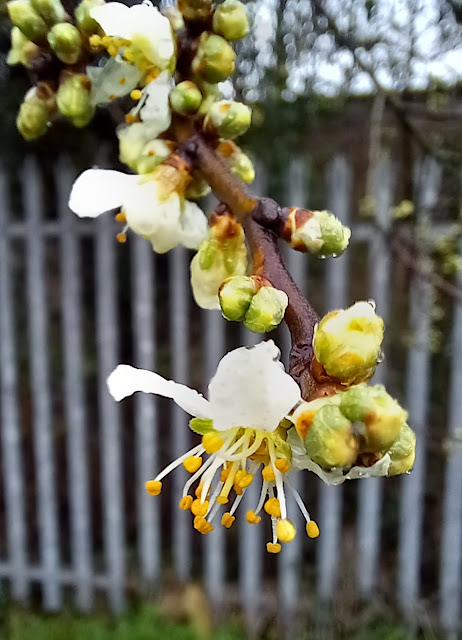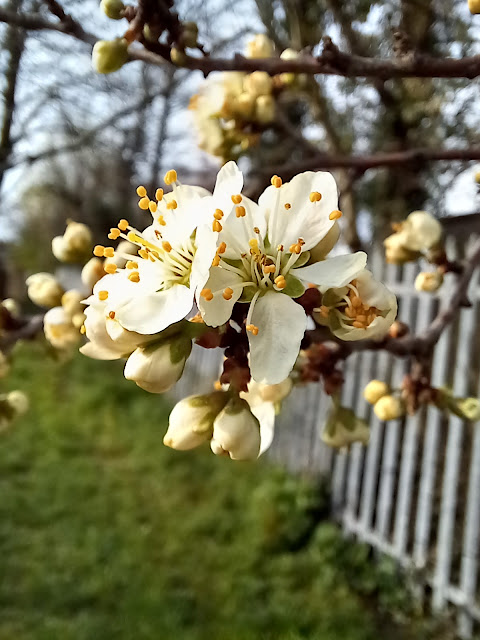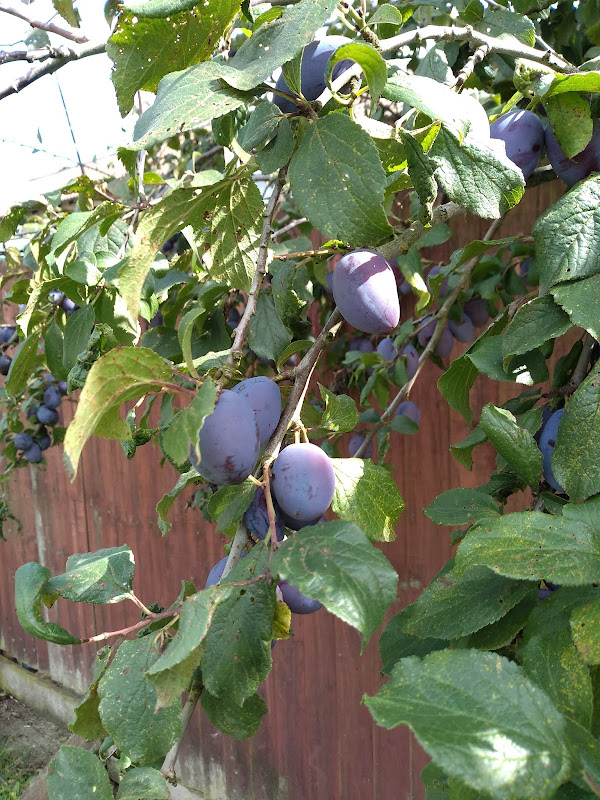Bullaces
 |
| Bullace (Prunus domestica ssp. institia) |
Bullaces, along with damson and sometimes other smallish plums such as gages and mirabelles, have been called Prunus institia, or (which I think is better) Prunus domestica ssp. institia .
There seems to be no definite botanically-acceptable distinction between damson and bullace. But generally you more often hear of damsons in a garden context than a hedgerow context.
In 2015 the subject was discussed on the Facebook Wild Flower Group. The following ID tips come mostly from Richard JD Smith and Richard Collingridge.
P1 .Cherry-plum (P. cerasifera)
Small tree or shrub.
Normally without thorns, but sometimes thorny.
The earliest plum to blossom (Feb-Mar), and the leaves appear at the same time. Sepals normally reflexed. Longer flower-stalks and petals than P2.
Fruit round, ripens in July-August (the earliest plum), sweet-tasting; purple, red, orange, yellow, white. Fruit is always shiny (other plums have a matt bloom until it rubs off).
New growth twigs are usually green (the others are purplish).
P2. Blackthorn/Sloe (P. spinosa)
Usually a shrub, rarely a small tree.
Lots of thorns.
Bullaces are a common plant around Frome. (And probably everywhere else round here: I noticed huge quantities in Southwick Country Park, just over the Wiltshire border.) In April there's a wave of bullace blossom that appears just as the blackthorn blossom begins to fade. The greater height and the freshness of the blossom means you can pick it out from a distance. Then you can see just how much there is!
Fruit round, ripens in July-August (the earliest plum), sweet-tasting; purple, red, orange, yellow, white. Fruit is always shiny (other plums have a matt bloom until it rubs off).
New growth twigs are usually green (the others are purplish).
P2. Blackthorn/Sloe (P. spinosa)
Usually a shrub, rarely a small tree.
Lots of thorns.
Flowers a bit later than P1 (Mar-Apr) but overlapping with it. The flowers appear before the leaves. Sepals not reflexed, flower-stalks shorter than P1, petals (5-8mm) shorter than P1.
More fruits in a cluster than P3 or P4.
Fruits small, globose, extremely astringent (skin) and sour (flesh). Black-purple (may look blue because of bloom). Fruit ripens late, hardly usable until after first frost.
Fruit-stones not or scarcely flattened.
P3. Bullace (P. domestica ssp. institia, var "Bullace")
Shrub or small tree.
Usually not or scarcely thorned, but sometimes thorny.
Fruits small, globose, extremely astringent (skin) and sour (flesh). Black-purple (may look blue because of bloom). Fruit ripens late, hardly usable until after first frost.
Fruit-stones not or scarcely flattened.
P3. Bullace (P. domestica ssp. institia, var "Bullace")
Shrub or small tree.
Usually not or scarcely thorned, but sometimes thorny.
Flowers slightly later than P2, but overlapping with it. Flowers appear with leaves, normally.
Petals 7mm+. (Can be recognized from a distance as a wave of blossom on taller growth, just as P2 blossom moves past its best.)
Fruits less in a cluster than P2.
Fruit variable but usually larger than P2 (typically about double the diameter); smaller than P4. Globose. Sweeter than P2, but skin may still be astringent. Ripens end of August / early September. Black-purple, also yellow-to-reddish (e.g. "Shepherd's Bullace")
Fruit-stone more flattened than P2.
Upper leaf shiny.
Twigs hairy.
P4. Damson (P. domestica ssp. institia, var "Damson")
Small tree.
Rarely with any thorns.
Fruit variable but usually larger than P2 (typically about double the diameter); smaller than P4. Globose. Sweeter than P2, but skin may still be astringent. Ripens end of August / early September. Black-purple, also yellow-to-reddish (e.g. "Shepherd's Bullace")
Fruit-stone more flattened than P2.
Upper leaf shiny.
Twigs hairy.
P4. Damson (P. domestica ssp. institia, var "Damson")
Small tree.
Rarely with any thorns.
Flowers, about the same time as P3, with leaves.
Fruit a week or two earlier than P3, larger and more oval than P3. Sweet flesh, flattened stones. Purple.
Upper leaf not shiny.
Twigs not hairy.
[Incidentally, there are some botanists who reserve the name "Bullace" for the few garden varieties sold under that name. They call all the wildings "Wild Plum", a name that I would use only for wild specimens (e.g. orchard relics) of Prunus domestica ssp. domestica : large fruits, flattened stones and hairless twigs.]
Upper leaf not shiny.
Twigs not hairy.
[Incidentally, there are some botanists who reserve the name "Bullace" for the few garden varieties sold under that name. They call all the wildings "Wild Plum", a name that I would use only for wild specimens (e.g. orchard relics) of Prunus domestica ssp. domestica : large fruits, flattened stones and hairless twigs.]
 |
| Bullace buds. Frome, 29 March 2023. |
 |
| Bullace buds. Frome, 29 March 2023. |
 |
| First flowers on Bullace. Frome, 29 March 2023. |
 |
| Bullace buds turning cream-coloured. Frome, 7 April 2023. |
 |
| Bullace buds opening. Frome, 7 April 2023. |
 |
| Buds and flowers of Bullace. Frome, 8 April 2023. |
 |
| Flowers and buds of bullace. Frome, 8 April 2023. |
 |
| Bullace nearing full bloom. Frome, 10 April 2023. |
 |
| Bullace blossom. Frome, 10 April 2023. |
 |
| Bullace blossom. Frome, 10 April 2023. |
 |
| Bullace in full bloom. Frome, 12 April 2023. |
 |
| Bullace blossom just starting to go over. Frome, 14 April 2023. |
 |
| Bullaces, mixed up with honeysuckle. |
 |
| Bullaces, showing a couple of thorns |
Bullaces are a common plant around Frome. (And probably everywhere else round here: I noticed huge quantities in Southwick Country Park, just over the Wiltshire border.) In April there's a wave of bullace blossom that appears just as the blackthorn blossom begins to fade. The greater height and the freshness of the blossom means you can pick it out from a distance. Then you can see just how much there is!
Young bullace plants often spring up as weeds in gardens and are then grubbed out.
The local Frome folk-belief is that these unwelcome garden incomers are a sort of worthless cherry unique to the Frome area and they never produce any fruit. That is wrong on all counts.
It's true that the plants that spring up in gardens are never allowed to grow big enough to produce fruit. (Except in Laura's.)
But the fruit is a common sight in local hedges and thickets. For example, there's a fine harvest to be gathered next to Halfords on the local trading estate.
It's possible to eat bullaces raw as a survival food. You could even get to like them. They are a bit sour, but are much more palatable than sloes.
The best way to eat them is as a jam, with some extra sugar. Bullace jam has the same virtues as damson jam. Some people say it's even better!
The tedious challenge with bullaces is removing the stones. The stones are small and pitted, and the flesh does not come away from them cleanly. They float out during cooking, eventually.
I discovered by chance that if you freeze bullaces, then defrost them, the stones come out easily. Bullace pie beckoned, but in the end I never baked one; the small sourish plums were too perfect as a topping for my morning granola!
The local Frome folk-belief is that these unwelcome garden incomers are a sort of worthless cherry unique to the Frome area and they never produce any fruit. That is wrong on all counts.
It's true that the plants that spring up in gardens are never allowed to grow big enough to produce fruit. (Except in Laura's.)
But the fruit is a common sight in local hedges and thickets. For example, there's a fine harvest to be gathered next to Halfords on the local trading estate.
It's possible to eat bullaces raw as a survival food. You could even get to like them. They are a bit sour, but are much more palatable than sloes.
The best way to eat them is as a jam, with some extra sugar. Bullace jam has the same virtues as damson jam. Some people say it's even better!
The tedious challenge with bullaces is removing the stones. The stones are small and pitted, and the flesh does not come away from them cleanly. They float out during cooking, eventually.
I discovered by chance that if you freeze bullaces, then defrost them, the stones come out easily. Bullace pie beckoned, but in the end I never baked one; the small sourish plums were too perfect as a topping for my morning granola!
 |
| Bullaces / Woodbine |
 |
| Unripe bullace fruits. Southwick Country Park, 4 August 2020. |
 |
| Small bullace fruits. Swindon, 27 August 2020. |
 |
| Damson fruits. Frome, 22 August 2020. |
 |
| Damson blossom. Frome, 5 April 2023. |
Labels: Prunus


0 Comments:
Post a Comment
<< Home